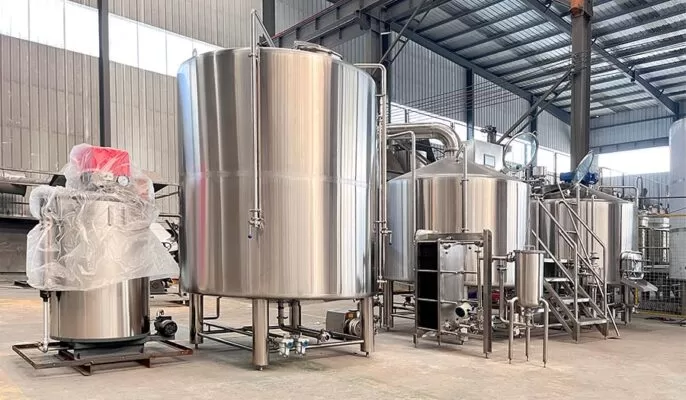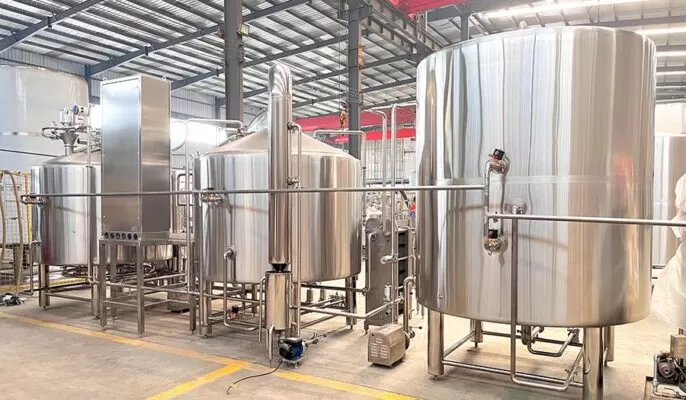The fastest method for heating your brewery equipment depends on the specific equipment you are using and the size of your brewing system. Different components of a brewery, such as mash tuns, boilers, and hot liquor tanks, may must different heating methods. This article will look at some common heating methods used in breweries, each with its speed and efficiency.
Steam heating
A steam jacket uses steam to heat the walls of the vessel and then transfers the heat to the liquid inside. Steam heats and , making it a common choice for large commercial breweries. It provides even heating and precise temperature control.
Steam heating has the largest surface to liquid ratio, so coupled with the high energy transfer to the process it can heat the wort very so there should be no problem reaching boiling at the end of filtration. They are also very energy efficient, so combined with running on natural gas, they cost less to run. Additionally, most local authorities must have expensive licenses and inspections to operate steam generators/boilers, which can slow down brewery start-up times.
Advantages of steam heating
- Rapid heating method for large brewery construction
- Short boiling time
- When combined with a gas boiler, you can get good (but not the best) heating efficiency and reduce energy costs
- Easier to clean than electric heating
Disadvantages of steam heating
- Due to the need to build a boiler system and a steam system, it is the most expensive heating method
- Used in small brewery equipment is usually not cost-effective
- Steam generators/boilers must be inspected and operated by local authorities in some countries and significant license and inspection fees must be obtained

Direct fire heating
Direct fire heating is a popular choice for home breweries and small commercial breweries. Direct fire heating is to install a power gas burner outside the kettle, and the burner projects the forced draft flame onto the baffle or diffuser of the enclosed combustion chamber below the kettle. This design reduces the risk of scorching while also providing good temperature control and steam-like heating rates. Forced air burners are low in NOx, efficient, safe and versatile.
Advantages of direct fire heating
- Save space
- Craft breweries can start with minimal upfront costs
- Some brewers prefer the caramelization effect brought by the system
Disadvantages of direct heating
- The heating efficiency of gas is usually only 25%~50%, which may become the most expensive heating method
- Fast heat dissipation
- Some craft breweries need fire suppression systems
- Construction and installation restrictions
- Difficult to clean
Electric heating
Electricity is the easiest way to heat a brewery. Electric heating elements are used in electric brewery systems. They are efficient and known for their accuracy in maintaining precise temperature levels. Although they may take longer to heat compared to gas burners, they provide consistent and reliable heating.
Electric heating systems are a popular choice for commercial brewing systems from 200L-1000L. heated brewery equipment includes heating tubes within the kettle to ensure greatest heating efficiency. 100% of the heat generated by electric heating will be transferred to the water or wort. This type of heating is common in homebrewing systems and small commercial breweries, and the temperature can be controlled.
Advantages of electric heating
- Efficient heating method for small brewery equipment
- 200L-1000L brewery equipment is cost-effective
- Good temperature control during brewing process;
- Predictable costs
Disadvantages of electric heating
- The cost of electric heating is usually higher than that of steam heating
- The initial cost of equipment is usually higher than direct fire heating, but lower than steam heating
- The heating speed of electric heating is very slow, which will extend your brewing time;
- After brewing, you need to remove the electrical components for cleaning
Which heating method is right for your brewery?
The fastest method of heating your brewery equipment may vary depending on your specific setup and needs. When choosing a heating method, it is important to consider factors such as the size of the brewery, the type of beer being brewed, and the energy available. Additionally, efficiency, control and safety should be considered when choosing heating equipment.

| Heating Options | Direct Fire Heating | Steam Heating | Electric Heating |
| Tank structure features | The kettle/HLT is built with a fire chamber with an inspection manway, burner mounting port, and flue port | The kettle/HLT is welded with a steam jacket to be able to heat by steam | The kettle/HLT is mounted with electric heating coils inside |
| Extra equipment | 2 burners: burner for the kettle(1 Set), burner for HLT(1 Set) | The kettle and HLT share the same set of steam boilers, and also suitable steam piping& valves, etc | No |
| Fuel requirement | It can be LPG or natural gas. Please kindly let the burner supplier advise the suitable burner capacity according to the required thermal power. For example, 300L kettle thermal power: 18kw | It can be LPG or natural gas or electricity. Please kindly let the boiler supplier advise the suitable boiler capacity according to the required thermal power | No |
| Building construction | A vent port to let flue extend outside the room | Better have an independent small room(1-2 square meters) to put the steam boiler, just beside the brewhouse | Enough electricity powerm |
| Electric requirement | Within 30kw for the whole set of the brewhouse(including pumps, chillers, motors, etc) | Within 30kw for the whole set of the brewhouse(including pumps, chillers, motors, etc) | Normally big. For example, 500l system: More than 80KW. |
| Recommended use capacity | 500L-2000L Brewhouse | Brewhouse above 500L | 50L-1500L Brewhouse |
Which brewery heating method is better?
Electric heating is suitable for 1-10BBL beer bars:
- The first advantage is the highest energy conversion since 100% of the electrical energy is converted into thermal energy for heating the wort/water
- The most cost-effective option than steam and gas heating because it does not need any auxiliary equipment and infrastructure investment
- No need to worry about carbon monoxide, open flames or explosive gases
- The site requires a considerable power supply. After all, a 10BBL kettle costs almost 50KW, which is very suitable for brewkits below 5BBL.
Direct fire heating 5-10BBL Ideal heating method for small breweries:
- Preferred caramelization can occur via a gas system
- It avoids high investment in steam generators and also solves the problem of on-site power supply requirements for electric brewing equipment.
- But due to the lowest energy conversion (about 20-50%), it may be the most expensive option in the future
- Requires some fire protection infrastructure and may must approval from government departments
- There are strict emission requirements in some areas, so you need to check with the burner supplier and ensure that it meets the relevant standards.
Steam heating: the professional heating method for commercial breweries:
- Best process and quality control, especially the saccharification stage, such as heating, heat preservation, etc.
- Direct fire heating steam generator is recommended, which has better energy conversion efficiency and lower cost.
In conclusion
For large commercial breweries, steam jacketed heating is often preferred for its heating efficiency and control. Electric heating is popular in small units because of their ability to heat and . No matter which method you choose, it’s important to follow safety guidelines and watch the heating process to avoid scorching or other issues that could affect the quality of your beer. If you have any questions or needs about brewing equipment, you can contact Micet’s professional technical engineers to find answers.




